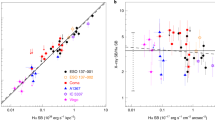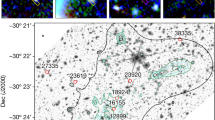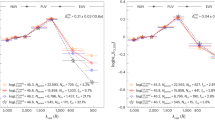Abstract
Recently, Barr and Mushotzky1 have claimed that a significant correlation exists between the X-ray luminosity and the timescale of X-ray variability for Seyfert galaxies and quasars. In particular, they find that log Lx = a1 log Δt + b1 with a1 = 0.9 ±0.2, b1 = 39 ± 1 and linear correlation coefficient r = 0.7 (hereafter fit 1), as would be expected if these objects have a universal efficiency of conversion of matter into energy (η ≥ 0.005, ref. 2). Furthermore, this result indicates that the emitting plasma is close to the Eddington luminosity limit, where electron-positron pair effects may dominate the hard X-ray photon fluxes3. In view of the physical meaning implied by their linear relationship and of its possible widespread use in the literature as a way of deriving constraints on the masses of active galactic nuclei4,5, the method of analysis and its statistical significance should be examined carefully. In particular, because in this case both variables, Lx and Δt, are affected by experimental errors, their least squares fitting procedure is inaccurate and a more general approach must be taken. Applying this more generalized fit to the same data set, we obtain a slope a = 1.5 ± 0.2, significantly different from that found by Barr and Mushotzky and more acceptable in terms of goodness of the fit. When judged on the basis of their statistical significance, both results are, in any case, too weak to be conclusive, and any physical conclusions drawn from them are therefore debatable.
This is a preview of subscription content, access via your institution
Access options
Subscribe to this journal
Receive 51 print issues and online access
$199.00 per year
only $3.90 per issue
Buy this article
- Purchase on Springer Link
- Instant access to full article PDF
Prices may be subject to local taxes which are calculated during checkout
Similar content being viewed by others
References
1. Barr, P. & Mushotzky, R. F. Nature 320, 421–423 (1985). 2. Fabian A. C. Proc. R. Soc. 366, 449–453 (1979). 3. White N. E., Fabian, A. C. & Mushotzky R. F. Astr. Astrophys. 133, L9–L11 (1983). 4. Worrall, D. M. Proc. Workshop The Continuum Emission in Active Galactic Nuclei, January 1986, Tucson, Arizona (in the press). 5. Elvis, M., Czerny, B. & Wilkes, B. J. Proc. ESA Workshop The Physics of Accretion onto Compact Objects, April 1986, Tenerife, Spain (in the press). 6. Mack, C. Essentials of Statistics for Scientist and Technologists Ch. 12, 106–115 (Plenum, New York, 1967). 7. Bevington, P. R. Data Reduction and Error Analysis for the Physical Sciences Chs 6, 7, 92–133, 187–203 (McGraw–Hill, New York, 1969). 8. Beers, Y. Introduction to the Theory of Errors Ch. 6, 38–43 (Addison–Wesley, Reading, Massachusetts, 1962). 9. Efron, B. SIAM Rev. 21, 460–480 (1979). 10. Simpson, G. & Mayer–Hasselwander, H. Astr. Astrophys. 162, 340–348 (1986).
Author information
Authors and Affiliations
Rights and permissions
About this article
Cite this article
Stephen, J., Bassani, L., Caroli, E. et al. Statistical significance of the relationship between X-ray luminosity and variability timescale in active galactic nuclei. Nature 328, 784–785 (1987). https://doi.org/10.1038/328784a0
Received:
Accepted:
Issue Date:
DOI: https://doi.org/10.1038/328784a0
Comments
By submitting a comment you agree to abide by our Terms and Community Guidelines. If you find something abusive or that does not comply with our terms or guidelines please flag it as inappropriate.



